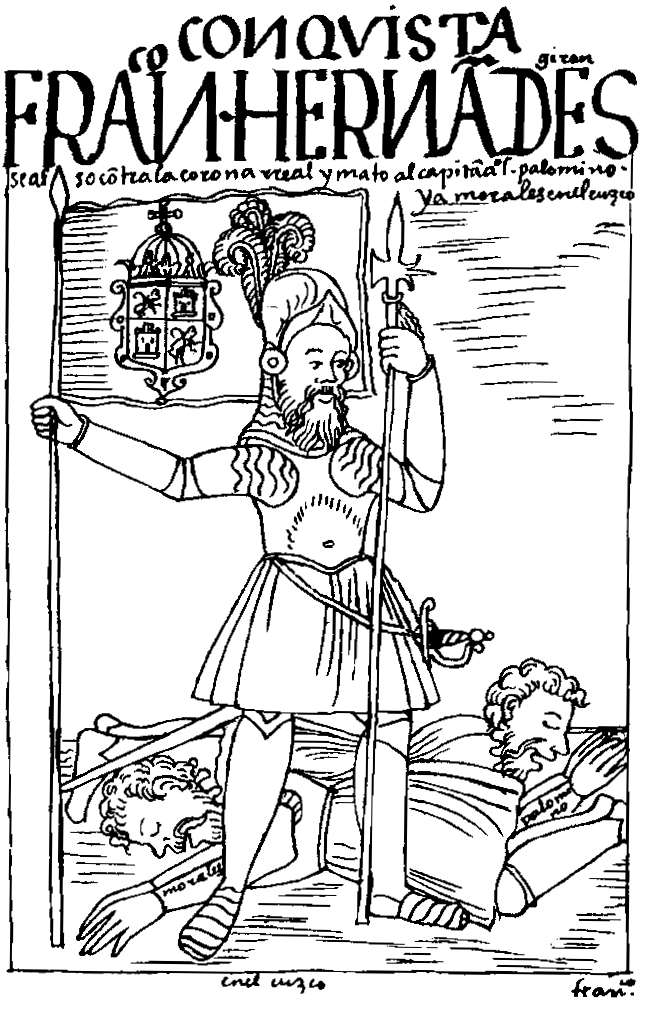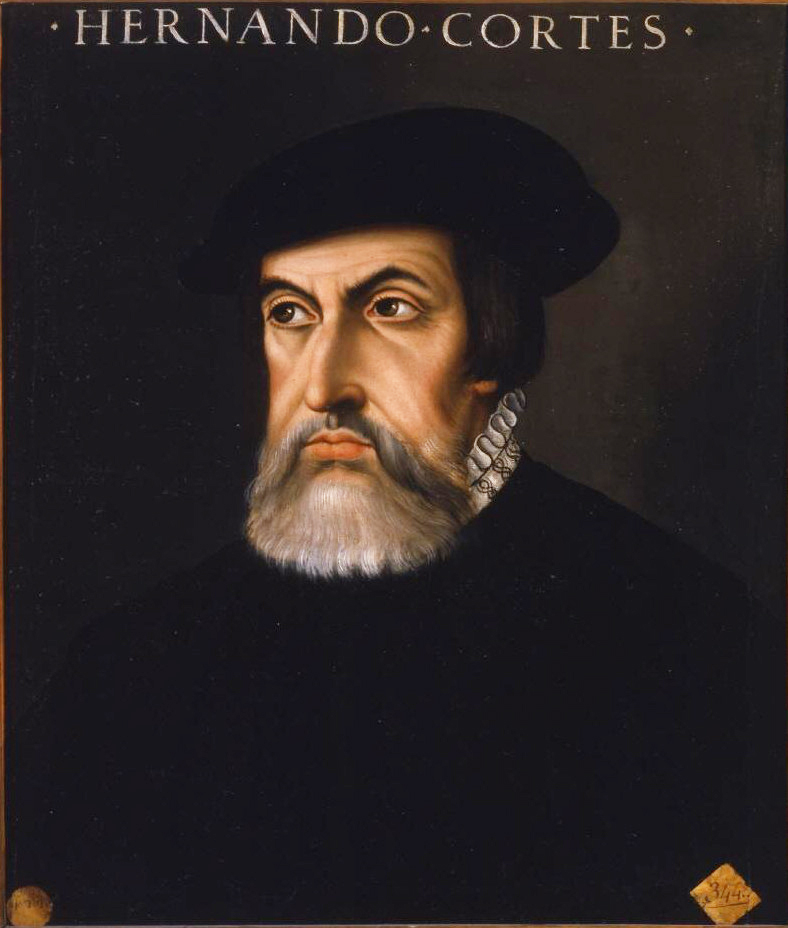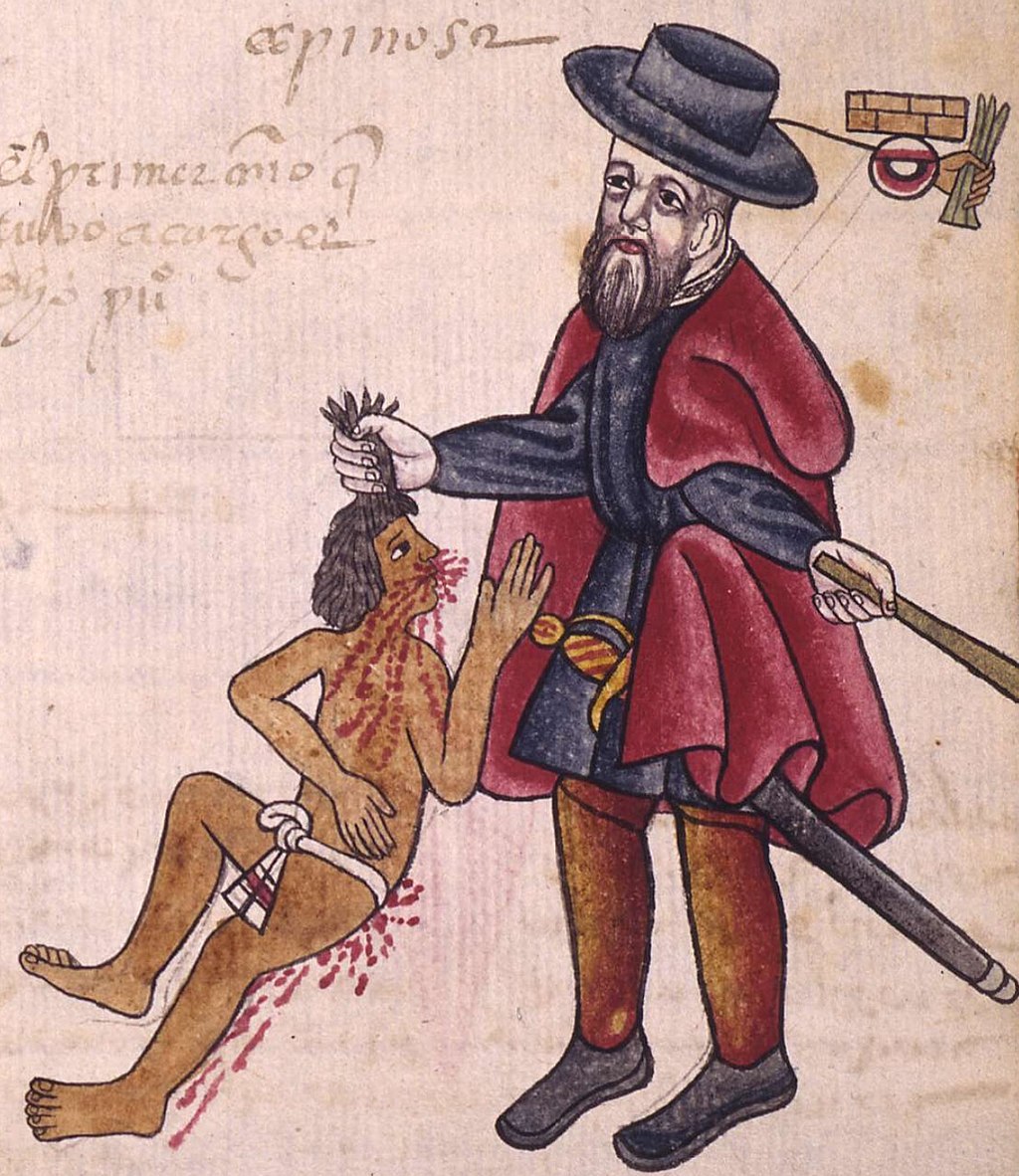
エンコミエンダ
Encomienda

Francisco Hernández Girón was a Spanish encomendero in the Viceroyalty of Peru who protested the New Laws in 1553. These
laws, passed in 1542, gave certain rights to indigenous peoples and
protected them against abuses. Drawing by Felipe Guamán Poma de Ayala. フランシスコ・エルナンデス・ジロンはペルー総督府のスペイン人エンコメンデロで、1553年に新法に抗議した。1542年に成立したこの法律は、先住民族に一定の権利を与え、虐待から保護するものであった。フェリペ・グアマン・ポマ・デ・アヤラによるデッサン。
☆
エンコミエンダ(スペイン語発音:[eŋkoˈmjenda]
ⓘ)は、征服した非キリスト教民族の労働を征服者に報酬として与えるスペインの労働制度であった。理論上、征服者は労働者に軍事的保護や教育などの恩恵を
与えた。エンコミエンダはキリスト教のレコンキスタ後にスペインで初めて確立され、スペインがアメリカ大陸とスペイン領東インド諸島を植民地化した際に、
より大規模に適用された。征服された民族はスペイン君主の家臣とみなされた。王室は特定の個人に対してエンコミエンダを付与した。16世紀初頭の征服時代
には、エンコミエンダはエンコメンデロと呼ばれる付与権者によって永続的に保持される、特定の先住民グループの労働力の独占とみなされていた。1542年
の新法から、エンコミエンダはエンコメンデロの死亡によって終了し、レパルティミエントに取って代わられた[1][2]。
エンコミエンダは本来のイベリア半島の形態から、共同体的な奴隷制の形態へと発展した。エンコミエンダでは、スペイン王室は特定のコミュニティから指定さ
れた数の原住民を個人に与えたが、コミュニティ内のどの個人が労働力を提供しなければならないかは指示しなかった。先住民の指導者は、その年貢と労働力を
動員する役割を担っていた。エンコメンデロは、先住民にカトリシズムとスペイン語の教育を施し、紛争部族や海賊から保護し、スペイン人に対する反乱を鎮圧
し、インフラを維持する役割を担った。原住民は金属、トウモロコシ、小麦、豚肉、その他の農産物の形で貢物を提供した。
1500年にクリストファー・コロンブスが追放されると、スペイン王室は彼に代わってフランシスコ・デ・ボバディージャを任命した。ボバディージャの後任
には王室総督のフレイ・ニコラス・デ・オバンドが就任し、正式なエンコミエンダ制度を確立した。多くの場合、原住民は過酷な労働を強いられ、抵抗すれば極
刑や死に追いやられた。
[しかし、カスティーリャ女王イザベラ1世は原住民の奴隷制を禁止し、原住民を「王家の自由な家臣」とみなした。1512年以降、さまざまなバージョンの
印度法が制定され、入植者と原住民の交流を規制しようとした。先住民もスペイン人も、エンコミエンダ制度による救済を求めてレアル・アウディエンシアスに
訴えた。
エンコミエンダはしばしば奴隷の地理的な移動と共同体や家族単位の崩壊を特徴としてきたが、ヌエバ・エスパーニャでは、エンコミエンダは既存の共同体階層
を通じて王家の自由な家臣を支配し、原住民は家族とともに集落に留まった。
| The encomienda
(Spanish pronunciation: [eŋkoˈmjenda] ⓘ) was a Spanish labour system
that rewarded conquerors with the labour of conquered non-Christian
peoples. In theory, the conquerors provided the labourers with
benefits, including military protection and education. The encomienda
was first established in Spain following the Christian Reconquista, and
it was applied on a much larger scale during the Spanish colonization
of the Americas and the Spanish East Indies. Conquered peoples were
considered vassals of the Spanish monarch. The Crown awarded an
encomienda as a grant to a particular individual. In the conquest era
of the early sixteenth century, the grants were considered a monopoly
on the labour of particular groups of indigenous peoples, held in
perpetuity by the grant holder, called the encomendero; starting from
the New Laws of 1542, the encomienda ended upon the death of the
encomendero, and was replaced by the repartimiento.[1][2] Encomiendas devolved from their original Iberian form into a form of communal slavery. In the encomienda, the Spanish Crown granted a person a specified number of natives from a specific community but did not dictate which individuals in the community would have to provide their labour. Indigenous leaders were charged with mobilising the assessed tribute and labour. In turn, encomenderos were to ensure that the encomienda natives were given instruction in Catholicism and the Spanish language, to protect them from warring tribes or pirates; to suppress rebellion against Spaniards, and maintain infrastructure. The natives provided tributes in the form of metals, maize, wheat, pork, and other agricultural products. With the ousting of Christopher Columbus in 1500, the Spanish Crown had him replaced with Francisco de Bobadilla.[3] Bobadilla was succeeded by a royal governor, Fray Nicolás de Ovando, who established the formal encomienda system.[4] In many cases natives were forced to do hard labour and subjected to extreme punishment and death if they resisted.[5] However, Queen Isabella I of Castile forbade slavery of the native population and deemed the indigenous to be "free vassals of the crown".[6] Various versions of the Laws of the Indies from 1512 onwards attempted to regulate the interactions between the settlers and natives. Both natives and Spaniards appealed to the Real Audiencias for relief under the encomienda system. Encomiendas have often been characterized by the geographical displacement of the enslaved and breakup of communities and family units, but in New Spain, the encomienda ruled the free vassals of the crown through existing community hierarchies, and the natives remained in their settlements with their families.[7][page needed] |
エンコミエンダ(スペイン語発音:[eŋkoˈmjenda]
ⓘ)は、征服した非キリスト教民族の労働を征服者に報酬として与えるスペインの労働制度であった。理論上、征服者は労働者に軍事的保護や教育などの恩恵を
与えた。エンコミエンダはキリスト教のレコンキスタ後にスペインで初めて確立され、スペインがアメリカ大陸とスペイン領東インド諸島を植民地化した際に、
より大規模に適用された。征服された民族はスペイン君主の家臣とみなされた。王室は特定の個人に対してエンコミエンダを付与した。16世紀初頭の征服時代
には、エンコミエンダはエンコメンデロと呼ばれる付与権者によって永続的に保持される、特定の先住民グループの労働力の独占とみなされていた。1542年
の新法から、エンコミエンダはエンコメンデロの死亡によって終了し、レパルティミエントに取って代わられた[1][2]。 エンコミエンダは本来のイベリア半島の形態から、共同体的な奴隷制の形態へと発展した。エンコミエンダでは、スペイン王室は特定のコミュニティから指定さ れた数の原住民を個人に与えたが、コミュニティ内のどの個人が労働力を提供しなければならないかは指示しなかった。先住民の指導者は、その年貢と労働力を 動員する役割を担っていた。エンコメンデロは、先住民にカトリシズムとスペイン語の教育を施し、紛争部族や海賊から保護し、スペイン人に対する反乱を鎮圧 し、インフラを維持する役割を担った。原住民は金属、トウモロコシ、小麦、豚肉、その他の農産物の形で貢物を提供した。 1500年にクリストファー・コロンブスが追放されると、スペイン王室は彼に代わってフランシスコ・デ・ボバディージャを任命した[3]。ボバディージャ の後任には王室総督のフレイ・ニコラス・デ・オバンドが就任し、正式なエンコミエンダ制度を確立した[4]。多くの場合、原住民は過酷な労働を強いられ、 抵抗すれば極刑や死に追いやられた。 [しかし、カスティーリャ女王イザベラ1世は原住民の奴隷制を禁止し、原住民を「王家の自由な家臣」とみなした[6]。1512年以降、さまざまなバー ジョンの印度法が制定され、入植者と原住民の交流を規制しようとした。先住民もスペイン人も、エンコミエンダ制度による救済を求めてレアル・アウディエン シアスに訴えた。 エンコミエンダはしばしば奴隷の地理的な移動と共同体や家族単位の崩壊を特徴としてきたが、新スペインでは、エンコミエンダは既存の共同体階層を通じて王 家の自由な家臣を支配し、原住民は家族とともに集落に留まった[7][要ページ]。 |
| History The meaning of encomienda and encomendero stems from the Spanish verb encomendar, "to entrust". The encomienda was based on the reconquista institution in which adelantados were given the right to extract tribute from Muslims or other peasants in areas that they had conquered and resettled.[8] The encomienda system traveled to America with the implantation of Castilian law in Spanish territories. The system was created in the Middle Ages and was pivotal to allow for the repopulation and protection of frontier land during the reconquista. This system originated in the Catholic south of Spain to extract labour and tribute from Muslims (Moors) before they were exiled in 1492 after the Moorish defeat in the Granada War.[9] It was a method of rewarding soldiers and moneymen who defeated the Moors.[9] The encomienda established a system similar to a feudal relationship, in which military protection was traded for certain tributes or specific work. It was especially prevalent among military orders that were entrusted with the protection of frontier areas. The king usually intervened directly or indirectly in the bond, by guaranteeing the fairness of the agreement and intervening militarily in case of abuse. The encomienda system in Spanish America differed from the Peninsular institution. The encomenderos did not own the land on which the natives lived. The system did not entail any direct land tenure by the encomendero; native lands were to remain in the possession of their communities. This right was formally protected by the crown of Castile because the rights of administration in the New World belonged to this crown and not to the Catholic monarchs as a whole.[10] |
歴史 エンコミエンダ(encomienda)とエンコメンデロ(encomendero)の意味は、スペイン語の動詞encomendar「託す」に由来す る。エンコミエンダはレコンキスタ制度に基づくもので、アデランタードは征服し再定住した地域のイスラム教徒や他の農民から貢ぎ物を引き出す権利を与えら れていた[8]。 エンコミエンダ制度は、スペインの領土にカスティーリャの法律が導入されるとともに、アメリカにも伝わった。この制度は中世に作られ、レコンキスタの間、 開拓地の再定住と保護を可能にする極めて重要なものであった。この制度は、グラナダ戦争でムーア人が敗れた後の1492年に追放される前に、イスラム教徒 (ムーア人)から労働力と貢ぎ物を引き出すためにスペインのカトリック南部で生まれたものである。特に辺境地域の保護を任された軍事騎士団の間で広まっ た。国王は通常、契約の公正さを保証し、悪用された場合には軍事的に介入するなど、直接的または間接的にこの契約に介入した。 スペイン領アメリカにおけるエンコミエンダ制度は、半島の制度とは異なっていた。エンコミエンダは原住民が住む土地を所有していなかった。この制度では、 エンコメンデーロが直接土地を所有することはなく、先住民の土地は彼らの共同体が所有することになった。この権利はカスティーリャ王家によって正式に保護 された。なぜなら、新大陸における行政権は、カトリック君主全体ではなく、この王家に属していたからである[10]。 |
Encomenderos Hernán Cortés, conqueror of the Aztecs and premier encomendero of New Spain The first grantees of the encomienda system, called encomenderos, were usually conquerors who received these grants of labour by virtue of participation in a successful conquest. Later, some receiving encomiendas in New Spain (Mexico) were not conquerors themselves but were sufficiently well connected that they received grants. In his study of the encomenderos of early colonial Mexico, Robert Himmerich y Valencia divides conquerors into those who were part of Hernán Cortés' original expedition, calling them "first conquerors", and those who were members of the later Narváez expedition, calling them "conquerors". The latter were incorporated into Cortes' contingent. Himmerich designated as pobladores antiguos (old settlers) a group of undetermined number of encomenderos in New Spain, men who had resided in the Caribbean region prior to the Spanish conquest of the Aztec Empire. In the New World, the Crown granted conquistadores as encomendero, which is the right to extract labour and tribute from natives who were under Spanish rule. The encomienda system was established on the island of Hispaniola by Nicolás de Ovando, the third governor of the Spanish colony, in 1502. Some women and some indigenous elites were also encomenderos. Maria Jaramillo, the daughter of Marina and conqueror Juan Jaramillo, received income from her deceased father's encomiendas.[11] Two of Moctezuma's daughters, Isabel Moctezuma and her younger sister, Leonor Moctezuma, were granted extensive encomiendas in perpetuity by Hernán Cortés. Leonor Moctezuma married in succession two Spaniards, and left the encomiendas to her daughter by her second husband.[12][13][14] Vassal Inca rulers appointed after the conquest also sought and were granted encomiendas. The encomienda was essential to the Spanish crown's sustaining its control over North, Central and South America in the first decades after the colonization. It was the first major organizational law instituted on the continent, which was affected by war, widespread epidemics caused by Eurasian diseases, and resulting turmoil.[15] Initially, the encomienda system was devised to meet the needs of the early agricultural economies in the Caribbean. Later it was adopted to the mining economy of Peru and Upper Peru. The encomienda lasted from the beginning of the sixteenth century to the seventeenth century.[8] Philip II enacted a law on 11 June 1594 to establish the encomienda in the Philippines, where he made grants to the local nobles (principalía). They used the encomienda to gain ownership of large expanses of land, many of which (such as Makati) continue to be owned by affluent families.[16] |
エンコメンデロ エルナン・コルテス、アステカの征服者、ニュー・スペインのエンコメンデロ第一人者 エンコメンデロと呼ばれる最初のエンコミエンダ制度の付与者は、通常征服者であり、征服の成功によって労働力の付与を受けた。その後、ニュー・スペイン (メキシコ)でエンコミエンダを受けた者の中には、征服者ではなかったが、十分なコネクションがあったために交付を受けた者もいた。 ロバート・ヒメリッヒ・イ・バレンシアは、植民地時代初期のメキシコのエンコメンデロスに関する研究の中で、征服者をエルナン・コルテスの最初の遠征に参 加した者と、後のナルバエス遠征に参加した者に分け、彼らを「最初の征服者」と呼び、「征服者」と呼んでいる。後者はコルテスの遠征隊に編入された。ヒン メリヒは、スペインがアステカ帝国を征服する以前からカリブ海地域に居住していた、新スペインにおける不特定多数のエンコメンデロたちをポブラドレス・ア ンティグオス(旧定住者)と呼んだ。 新大陸では、スペイン王室はコンキスタドールにエンコメンデロ(スペイン統治下にあった原住民から労働力と貢ぎ物を搾取する権利)を与えた。エンコミエンダ制度は、1502年にスペイン植民地の第3代総督ニコラス・デ・オバンドによってイスパニョーラ島に確立された。 一部の女性や先住民のエリートもエンコメンデロだった。マリーナと征服者フアン・ハラミージョの娘マリア・ハラミージョは、亡き父のエンコミエンダから収 入を得ていた[11]。 モクテスマの2人の娘、イサベル・モクテスマとその妹レオノル・モクテスマは、エルナン・コルテスから永続的に広大なエンコミエンダを与えられた。レオノ ル・モクテスマは2人のスペイン人と相次いで結婚し、2番目の夫との娘にエンコミエンダを残した[12][13][14]。征服後に任命されたインカの臣 下支配者たちもエンコミエンダを求め、与えられた。 エンコミエンダは、植民地化後の最初の数十年間、スペイン王室が北アメリカ、中央アメリカ、南アメリカの支配を維持するために不可欠なものであった。戦 争、ユーラシア大陸の伝染病による伝染病の蔓延、そしてその結果としての混乱に見舞われたこの大陸で最初に制定された主要な組織法であった[15]。当 初、エンコミエンダ制度はカリブ海における初期の農業経済の必要性を満たすために考案された。その後、ペルーとペルー上部の鉱山経済に採用された。エンコ ミエンダは16世紀初頭から17世紀まで続いた[8]。 フィリップ2世は1594年6月11日、フィリピンにエンコミエンダを設立する法律を制定し、現地の貴族(プリンシパリア)に交付金を与えた。彼らはエン コミエンダを利用して広大な土地の所有権を獲得し、その多く(マカティなど)は現在も裕福な家族が所有している[16]。 |
| Establishment In 1501 Isabella I of Castile declared Native Americans as subjects to the Crown, and so, as Castilians and legal equals to Spanish Castilians. This implied that enslaving them was illegal except under very specific conditions. It also allowed the establishment of encomiendas, since the encomienda bond was a right reserved to full subjects to the crown. In 1503, the crown began to formally grant encomiendas to conquistadors and officials as rewards for service to the crown. The system of encomiendas was aided by the crown's organizing the indigenous into small harbors known as reducciones, with the intent of establishing new towns and populations. Each reducción had a native chief responsible for keeping track of the labourers in his community. The encomienda system did not grant people land, but it indirectly aided in the settlers' acquisition of land. As initially defined, the encomendero and his heirs expected to hold these grants in perpetuity. After a major Crown reform in 1542, known as the New Laws, encomendero families were restricted to holding the grant for two generations. When the Crown attempted to implement the policy in Peru, shortly after the 1535 Spanish conquest, Spanish recipients rebelled against the Crown, killing the viceroy, Blasco Núñez Vela. In Mexico, viceroy Antonio de Mendoza decided against implementing the reform, citing local circumstances and the potential for a similar conqueror rebellion. To the crown he said, "I obey crown authority but do not comply with this order."[17] The encomienda system was ended legally in 1720, when the crown attempted to abolish the institution. The encomenderos were then required to pay remaining encomienda labourers for their work. The encomiendas became very corrupt and harsh. In the neighborhood of La Concepción, north of Santo Domingo, the adelantado of Santiago heard rumors of a 15,000-man army planning to stage a rebellion.[18] Upon hearing this, the adelantado captured the caciques involved and had most of them hanged. Later, a chieftain named Guarionex laid havoc to the countryside before an army of about 3,090 routed the Ciguana people under his leadership.[19] Although expecting Spanish protection from warring tribes, the islanders sought to join the Spanish forces. They helped the Spaniards deal with their ignorance of the surrounding environment.[20] As noted, the change of requiring the encomendado to be returned to the crown after two generations was frequently overlooked, as the colonists did not want to give up the labour or power. According to the Codice Osuna, one of many colonial-era Aztec codices (indigenous manuscripts) with native pictorials and alphabetic text in Nahuatl, there is evidence that the indigenous were well aware of the distinction between indigenous communities held by individual encomenderos and those held by the Crown.[21] |
設立 1501年、カスティーリャのイザベラ1世は、アメリカ先住民を王室の臣民、つまりカスティーリャ人として、スペインのカスティーリャ人と法的に同等であ ると宣言した。これにより、彼らを奴隷にすることは、特別な条件下でない限り違法となった。また、エンコミエンダは王室の完全な臣民に与えられた権利で あったため、エンコミエンダの設立も許可された。1503年、王室はコンキスタドールや役人たちに、王室への奉仕の報酬として正式にエンコミエンダを与え るようになった。エンコミエンダの制度は、王権が先住民をレドゥッチョネスと呼ばれる小さな港に組織化し、新しい町と人口を確立することを目的としていた ことも手伝っていた。 各レドゥッチョンは先住民の長を置き、そのコミュニティの労働者を管理する責任を負っていた。エンコミエンダ制度は人々に土地を与えるものではなかった が、入植者の土地取得を間接的に助けた。当初は、エンコメンデロとその相続人が永続的に土地を所有することになっていた。1542年に新法として知られる 王室の大改革が行われた後、エンコメンデロ一族は2世代にわたって土地を所有することが制限された。1535年のスペインによる征服の直後、ペルーで王室 がこの政策を実施しようとしたとき、スペイン人受領者たちは王室に反抗し、総督ブラスコ・ヌニェス・ベラを殺害した。 メキシコでは、アントニオ・デ・メンドーサ総督が、現地の事情と同様の征服者の反乱の可能性を理由に、改革の実施を断念した。1720年、王権がエンコミ エンダ制度を廃止しようとしたため、エンコミエンダ制度は法的に廃止された。その後、エンコミエンダは、残ったエンコミエンダの労働者に労働の対価を支払 うことが義務づけられた。 エンコミエンダは非常に腐敗し、過酷なものとなった。サント・ドミンゴの北にあるラ・コンセプシオン近辺で、サンティアゴのアデランタードは、 15,000人の軍隊が反乱を計画しているという噂を耳にした[18]。これを聞いたアデランタードは、関係するカシキたちを捕らえ、そのほとんどを絞首 刑に処した。 その後、約3,090人の軍隊が彼の率いるシグアナ族を撃退する前に、グアリオネックスという首長が地方を大混乱に陥れた[19]。彼らはスペイン人が周囲の環境について無知であったことに対処する手助けをした[20]。 前述したように、2世代後にエンコメンダードを王権に返還することを義務付けるという変更は、植民者たちが労働力や権力を手放したくなかったため、しばし ば見過ごされた。植民地時代のアステカの写本(先住民の写本)のひとつであり、先住民の絵とナワトル語のアルファベット文字が記された『オスナ写本』によ れば、先住民は個々のエンコメンダーが所有する先住民共同体と王権が所有する先住民共同体との区別をよく認識していた証拠がある[21]。 |
| Reform and abolition Initial controversies The encomienda system was the subject of controversy in Spain and its territories almost from its start. In 1510, an Hispaniola encomendero named Valenzuela murdered a group of Native American leaders who had agreed to meet for peace talks in full confidence. The Taíno cacique Enriquillo rebelled against the Spaniards between 1519 and 1533. In 1538, Emperor Charles V, realizing the seriousness of the Taíno revolt, changed the laws governing the treatment of people labouring in the encomiendas.[22] Conceding to Las Casas's viewpoint, the peace treaty between the Taínos and the audiencia was eventually disrupted in four to five years.[clarification needed] The crown also actively prosecuted abuses of the encomienda system, through the Laws of Burgos (1512–13) and the New Laws of the Indies (1542). The priest of Hispaniola and former encomendero Bartolomé de las Casas underwent a profound conversion after seeing the abuse of the native people.[23] He dedicated his life to writing and lobbying to abolish the encomienda system, which he thought systematically enslaved the native people of the New World. Las Casas participated in an important debate, where he pushed for the enactment of the New Laws and an end to the encomienda system.[24] The Laws of Burgos and the New Laws of the Indies failed in the face of colonial opposition and, in fact, the New Laws were postponed in the Viceroyalty of Peru. When Blasco Núñez Vela, the first viceroy of Peru, tried to enforce the New Laws, which provided for the gradual abolition of the encomienda, many of the encomenderos were unwilling to comply with them and revolted against him. The New Laws of 1542 Main article: New Laws When the news of the abuse of the institution reached Spain, the New Laws were passed to regulate and gradually abolish the system in America, as well as to reiterate the prohibition of enslaving Native Americans. By the time the new laws were passed, in 1542, the Spanish crown had acknowledged their inability to control and properly ensure compliance of traditional laws overseas, so they granted to Native Americans specific protections not even Spaniards had, such as the prohibition of enslaving them even in the case of crime or war. These extra protections were an attempt to avoid the proliferation of irregular claims to slavery.[25] The liberation of thousands of Native Americans held in bondage throughout the Spanish empire by the new viceroy, Blasco Núñez Vela, on his journey to Peru, led to his eventual murder and armed conflict between the encomenderos and the Spanish crown which ended with the execution of those encomenderos involved.[26] Final abolition In most of the Spanish domains acquired in the 16th century the encomienda phenomenon lasted only a few decades. However, in Peru and New Spain the encomienda institution lasted much longer.[27] In Chiloé Archipelago in southern Chile, where the encomienda had been abusive enough to unleash a revolt in 1712, the encomienda was abolished in 1782.[28] In the rest of Chile it was abolished in 1789, and in the whole Spanish empire in 1791.[28][29][30][31] |
改革と廃止 当初の論争 エンコミエンダ制度は、開始当初からスペインとその領土で論争の的となった。1510年、ヒスパニョーラのバレンズエラというエンコメンデロが、和平交渉 に同意したネイティブ・アメリカンの指導者たちを殺害した。1519年から1533年にかけて、タイノ族のカチケ、エンリキージョがスペイン人に反抗し た。1538年、皇帝シャルル5世はタイノ族の反乱の深刻さに気づき、エンコミエンダで労働する人々の処遇を規定する法律を変更した[22]。ラス・カサ スの見解に同意し、タイノ族とオーディエンシアの間の和平条約は最終的に4~5年で破棄された[要出典]。 王室はまた、ブルゴス法(1512-13年)やインド新法(1542年)を通じて、エンコミエンダ制度の悪用を積極的に訴追した。 イスパニョーラの司祭であり、かつてはアンコメンデロであったバルトロメ・デ・ラス・カサスは、先住民の虐待を目の当たりにして深い改心をした。ラス・カ サスは重要な討論会に参加し、新法の制定とアンコミエンダ制度の廃止を推し進めた[24]。ブルゴス法とインド新法は植民地の反対を押し切って失敗に終わ り、実際、ペルー総督領では新法は延期された。ペルーの初代総督ブラスコ・ヌニェス・ベラが、エンコミエンダの段階的廃止を定めた新法を施行しようとした ところ、エンコミエンダの多くがこれに応じようとせず、反乱を起こした。 1542年の新法 主な記事 新法 エンコミエンダ制度の悪用がスペインに伝わると、アメリカにおけるエンコミエンダ制度を規制し、徐々に廃止するための新法が制定された。新法が成立した 1542年までには、スペイン王室は海外における伝統的な法律の遵守を管理し、適切に確保することができないことを認めていた。そのため、スペイン人です ら持っていなかった特別な保護、例えば犯罪や戦争の場合であってもアメリカ先住民を奴隷にすることを禁止することをアメリカ先住民に認めた。これらの特別 な保護は、非正規の奴隷請求権の拡散を避けるための試みであった[25]。 新総督ブラスコ・ヌニェス・ベラがペルーへの旅でスペイン帝国全土で拘束されていた数千人のアメリカ先住民を解放したことで、彼は最終的に殺害され、エンコメンデロとスペイン王家の間で武力衝突が起こり、エンコメンデロ関係者の処刑で幕を閉じた[26]。 最終的な廃止 16世紀に獲得されたほとんどのスペイン領では、エンコミエンダ現象は数十年しか続かなかった。しかしペルーとニュー・スペインでは、エンコミエンダ制度はもっと長く続いた[27]。 チリ南部のチロエ群島では、1712年に反乱を起こすほどエンコミエンダが酷使されていたが、1782年に廃止された[28]。 チリの他の地域では1789年に、スペイン帝国全体では1791年に廃止された[28][29][30][31]。 |
| Repartimiento The encomienda system was generally replaced by the crown-managed repartimiento system throughout Spanish America after mid-sixteenth century.[8] Like the encomienda, the new repartimiento did not include the attribution of land to anyone, rather only the allotment of native workers. But they were directly allotted to the Crown, who, through a local Crown official, would assign them to work for settlers for a set period of time, usually several weeks. The repartimiento was an attempt "to reduce the abuses of forced labour".[8] As the number of natives declined and mining activities were replaced by agricultural activities in the seventeenth century, the hacienda, or large landed estates in which labourers were directly employed by the hacienda owners (hacendados), arose because land ownership became more profitable than acquisition of forced labour.[32] |
レパルティミエント エンコミエンダ制度は、16世紀半ば以降、一般的にスペイン領アメリカ全土で、王権が管理するレパルティミエント制度に取って代わられた[8]。エンコミ エンダと同様に、新しいレパルティミエントには土地の帰属は含まれず、先住民労働者の割り当てのみが行われた。しかし、労働者は直接王権に割り当てられ、 王権は地元の王権役人を通じて、一定期間(通常は数週間)入植者のために労働させることにした。レパルティミエントは「強制労働の悪用を減らす」試みで あった[8]。17世紀に先住民の数が減少し、鉱業活動が農業活動に取って代わると、強制労働の獲得よりも土地所有の方が利益を生むようになったため、ハ シエンダ、すなわち労働者がハシエンダ所有者(ハセンダドス)に直接雇用される大規模な土地所有地が生まれた[32]。 |
| Deaths, disease, and genocide See also: Taíno genocide and Population history of indigenous peoples of the Americas  The Codex Kingsborough: also known as the Codex Tepetlaoztoc, is a 16th-century Mesoamerican pictorial manuscript which was part of a lawsuit against the Spanish encomenderos for mistreatment Raphael Lemkin (coiner of the term genocide) considered Spain's abuses of the native population of the Americas to constitute cultural and even outright genocide, including the abuses of the encomienda system. He described slavery as "cultural genocide par excellence" noting "it is the most effective and thorough method of destroying culture, of desocializing human beings".[33][citation needed] Economic historian Timothy J. Yeager argued the encomienda was deadlier than conventional slavery because of an individual labourer's life being disposable in the face of simply being replaced with a labourer from the same plot of land.[34] University of Hawaii historian David Stannard describes the encomienda as a genocidal system which "had driven many millions of native peoples in Central and South America to early and agonizing deaths".[35] Yale University's genocide studies program supports this view regarding abuses in Hispaniola.[36] The program cites the decline of the Taíno population of Hispaniola in 1492 to 1514 as an example of genocide and notes that the indigenous population declined from a population between 100,000 and 1,000,000 to only 32,000 a decline of 68% to over 96%.[36] Historian Andrés Reséndez contends that enslavement in gold and silver mines was the primary reason why the Native American population of Hispaniola dropped so significantly, as the conditions that native peoples were subjected to under enslavement, from forced relocation to hours of hard labour, contributed to the spread of disease.[37][38] For example, according to anthropologist Jason Hickel, a third of Arawak workers died every six months from forced labour in the mines.[39] Skepticism toward accusations of genocide Skepticism towards accusations of genocide linked to the encomienda and the Spanish conquest and settlement of the Americas typically involve arguments like those of Noble David Cook, wherein scholars posit that accusations of genocide are a continuation of the Spanish Black Legend. Writing about the Black Legend and the conquest of the Americas, Cook wrote, "There were too few Spaniards to have killed the millions who were reported to have died in the first century after Old and New World contact" and instead suggests the near total decimation of the indigenous population of Hispaniola as mostly having been caused by diseases like smallpox. He argues that the Spanish unwittingly carried these diseases to the New World.[40] |
死、病気、大虐殺 以下も参照のこと: タイノ人大量虐殺とアメリカ大陸先住民の人口史  キングズボロ写本:テペトラオズトック写本としても知られ、16世紀のメソアメリカの絵画写本である。 ラファエル・レムキン(ジェノサイドという言葉の生みの親)は、スペインによるアメリカ大陸の先住民に対する虐待を、文化的な、さらには明白なジェノサイ ドとみなした。彼は奴隷制を「文化的ジェノサイドの最たるもの」とし、「文化を破壊し、人間を非社会化する最も効果的で徹底的な方法である」と指摘した [33][要出典] 経済史家のティモシー・J. ハワイ大学の歴史家デイヴィッド・スタナードは、エンコミエンダは「中南米の何百万人もの先住民を早期に苦悶の死に追いやった」大量虐殺システムであると 述べている[35]。 エール大学のジェノサイド研究プログラムは、ヒスパニョーラでの虐待に関するこの見解を支持している[36]。同プログラムはジェノサイドの例として、 1492年から1514年にかけてのヒスパニョーラのタイノ族の人口減少を挙げ、先住民の人口が10万人から100万人の間からわずか3万2千人へと 68%から96%以上減少したことを指摘している。 [36]歴史家のアンドレス・レゼンデスは、金銀鉱山での奴隷化がヒスパニョーラのアメリカ先住民の人口を著しく減少させた主な理由であると主張してい る。強制的な移転から過酷な労働時間まで、奴隷化の下で先住民が受けた状況が病気の蔓延を助長したからである[37][38]。例えば、人類学者のジェイ ソン・ヒッケルによれば、アラワク族の労働者の3分の1が半年ごとに鉱山での強制労働によって死亡していた[39]。 ジェノサイドの告発に対する懐疑論 エンコミエンダやスペインによるアメリカ大陸の征服と入植に関連するジェノサイドの告発に対する懐疑論は、一般的にノーブル・デイヴィッド・クックのよう な議論を含んでいる。黒伝説とアメリカ大陸征服について書いたクックは、「旧世界と新世界の接触後1世紀に死亡したとされる数百万人を殺すには、スペイン 人の数が少なすぎた」と書き、その代わりに、ヒスパニョーラの先住民のほぼ全滅は、天然痘のような病気が原因であったことを示唆している。彼はスペイン人 が知らず知らずのうちにこれらの病気を新世界に持ち込んだと主張している[40]。 |
| Polo y servicio, a similar forced labor system in Spanish-controlled colonial Philippines Cargo system Encomiendas in Peru History of Cusco Gregorio de San Juan Historiography of Colonial Spanish America Jesuit reductions Reductions Serfdom Guaraní people |
ポロ・イ・セルビシオ、スペイン統治下の植民地フィリピンにおける同様の強制労働制度 貨物システム ペルーのエンコミエンダ クスコの歴史 グレゴリオ・デ・サンファン 植民地時代のスペイン領アメリカの歴史学 イエズス会の削減 削減 農奴制 グアラニー族 |
| https://en.wikipedia.org/wiki/Encomienda |
|
リ ンク
文 献
そ の他の情報
Copyleft,
CC, Mitzub'ixi Quq Chi'j, 1996-2099